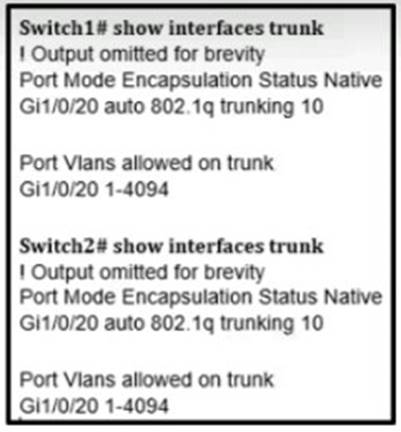- (Topic 2)
Refer to the exhibit.
The trunk does not work over the back-to-back link between Switch1 interface Giq1/0/20 and Switch2 interface Gig1/0/20. Which configuration fixes the problem?
A)
B)
C)
D)
Correct Answer:
B
- (Topic 4)
A customer requires their wireless network to be fully functional, even if the wireless controller fails. Which wireless design supports these requirements?
Correct Answer:
A
This is because FlexConnect is a feature that allows wireless access points to operate in standalone mode when they lose connectivity to the wireless LAN controller. FlexConnect enables the access points to switch the data traffic locally, without sending it to the controller, and to perform local authentication, without relying on the central server. FlexConnect also allows the access points to maintain the wireless network functionality, such as SSIDs, security policies, and QoS, even if the wireless controller fails. FlexConnect is suitable for branch locations or remote offices that have limited WAN bandwidth or reliability. The source of this answer is the Cisco ENCOR v1.1 course, module 7, lesson 7.3: Implementing FlexConnect.
- (Topic 4)
An engineer must contigure a rou'.er to allow users to run specHic configuration commands by validating the user against the router database. Which configuration must be applied?
Correct Answer:
C
- (Topic 4)
Which two results occur if Cisco DNA center loses connectivity to devices in the SD- ACCESS fabric? (Choose two)
Correct Answer:
CD
- (Topic 2)
What are two benefits of implementing a Cisco SD-WAN architecture? (Choose two)
Correct Answer:
CD
The top SD-WAN benefits are:
+ Increased bandwidth at a lower cost
+ Centralized management across branch networks
+ Full visibility into the network
+ Providing organizations with more connection type options and vendor selection when building a network.
Reference: https://www.sdxcentral.com/networking/sd-wan/definitions/sd-wan-technology/
-> We can provision endpoints (vEdges) through a centralized router vManage -> Answer D is correct.
Answer A is not correct as we can use different kind of connections on SD-WAN: MPLS,
LTE, 4G, xDSL, Internet connections…
Application-Aware Routing policy is configured in vManage as a centralized data policy that maps the service- side application(s) to specific SLA requirements. The centralized policies provisioned in vSmart controller is pushed to relevant WAN Edge devices for enforcement. The defined policy consists of match- action pairs, where the match statement defines the application-list or the type of traffic to match, and the action statement defines the SLA action the WAN Edge devices must enforce for the specified traffic.
Reference: https://www.cisco.com/c/en/us/td/docs/solutions/CVD/SDWAN/cisco-sdwan- application-awarerouting-deploy-guide.html

